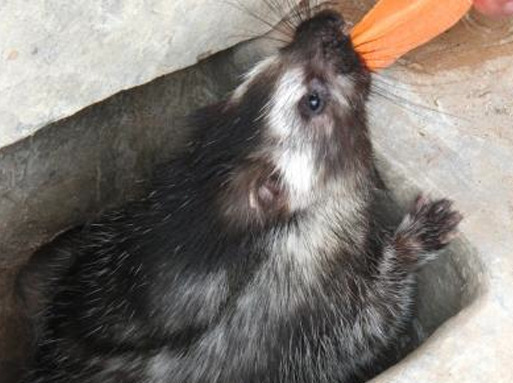
Mammals have all sorts of interesting and novel defense tactics: sharp quills, stinky spray, and clever camouflage, among others. Some mammals even produce poison to deter predators looking for a meal. Now, scientists have identified the first mammal that uses poison—but gets it from another species. Last week’s issue of Proc B reports that the African crested rat chews bark from a particular plant, then smears the slimy paste onto specialized hairs that can deliver the toxin to a hungry predator’s mouth.
The African crested rat is a large gray rodent that lives in (wait for it...) Africa. It resembles a porcupine at first glance. In general, these rats are pretty sluggish and inconspicuous but, when threatened, they fluff up a row of hairs along their backs, exposing a bright black and white pattern. They also turn away from the predator, pointing their hairy mohawks and brightly patterned flanks toward the threat. Until recently, scientists weren’t sure why such a slow-moving animal would seemingly invite an attack with this bold display.
But an in-depth study of the African crested rat shows that this display, as well as the morphology of the rat, is a highly evolved method to deter predators. First, the rats chew up bark from the a particular type of East African tree, called Acokanthera schimperi. Once the bark softens, the rats smear the paste on the specialized hairs along its back. If the rat drops any of the chewed bark, he carefully picks it up and smears these pieces on as well. The rats perform this behavior regularly; a wild-caught rat in captivity prepped himself with poison three times over five days.
Using an scanning electron microscope, the scientists found that these particular hairs are structured to store and deliver poison. The toxin in the bark is absorbed into the hair through capillary action and stored inside the hair shaft. Once this process is complete, touching the hairs will deliver a large dose of strong toxin.
The toxin found in the bark of in A. schimperi is called ouabain, and has long been used in offensive weaponry: poison-tipped arrows made by humans. Ouabain increases the force of muscle contractions in the heart, leading to a loss of coordination, collapse, and sometimes death.
Here is where the rat's strange defensive behavior comes in: to maximize the chance of a predator's delicate mouth coming into contact with the toxin, the rat turns its back and fluffs up these particular poison-holding hairs. If the predator hasn't come into contact with the rat before, it will probably bite, getting a large dose of toxin delivered directly into its mouth. If it survives the ordeal, the next time the predator sees the memorable black and white pattern, it will probably think twice about taking the bait.
There are still many unanswered questions about this defense tactic, including one that should be obvious: why don't the rats poison themselves while chewing the bark? This is the first known example of a non-human mammal acquiring a poisonous compound from another species and using it for its own defense. The entire suite of adaptations, from bark-chewing to specialized hairs to defensive behavior, is an elegant solution to nearly every animal's task of defending itself against predators.
Proceedings of the Royal Society B, 2011. DOI: (About DOIs).
Listing image by Photograph by NSF
reader comments
27